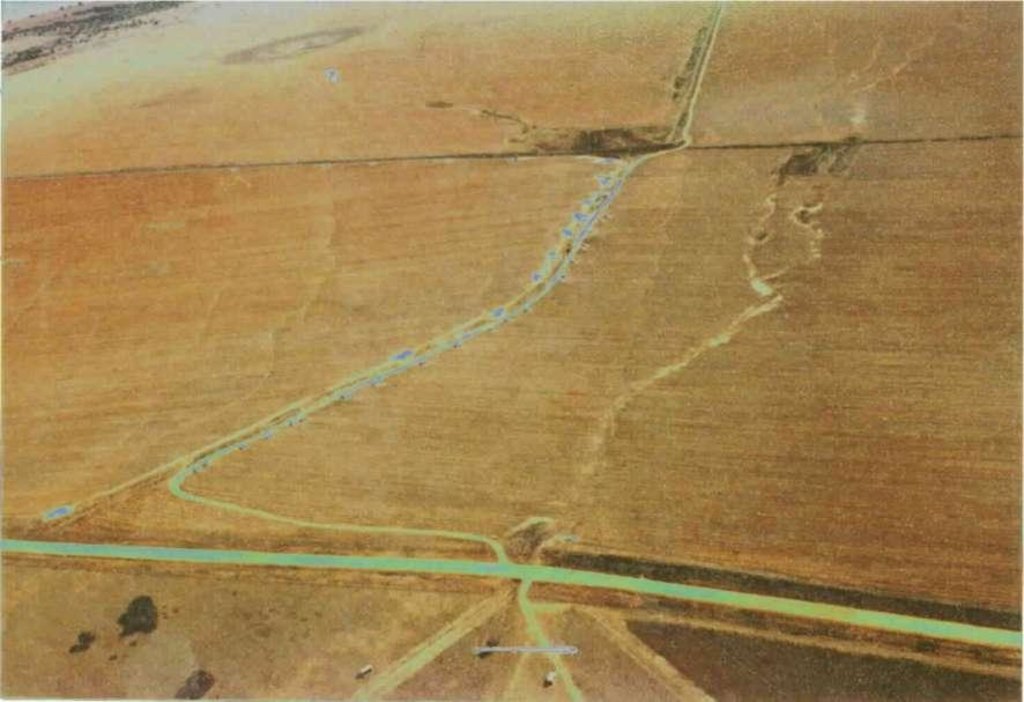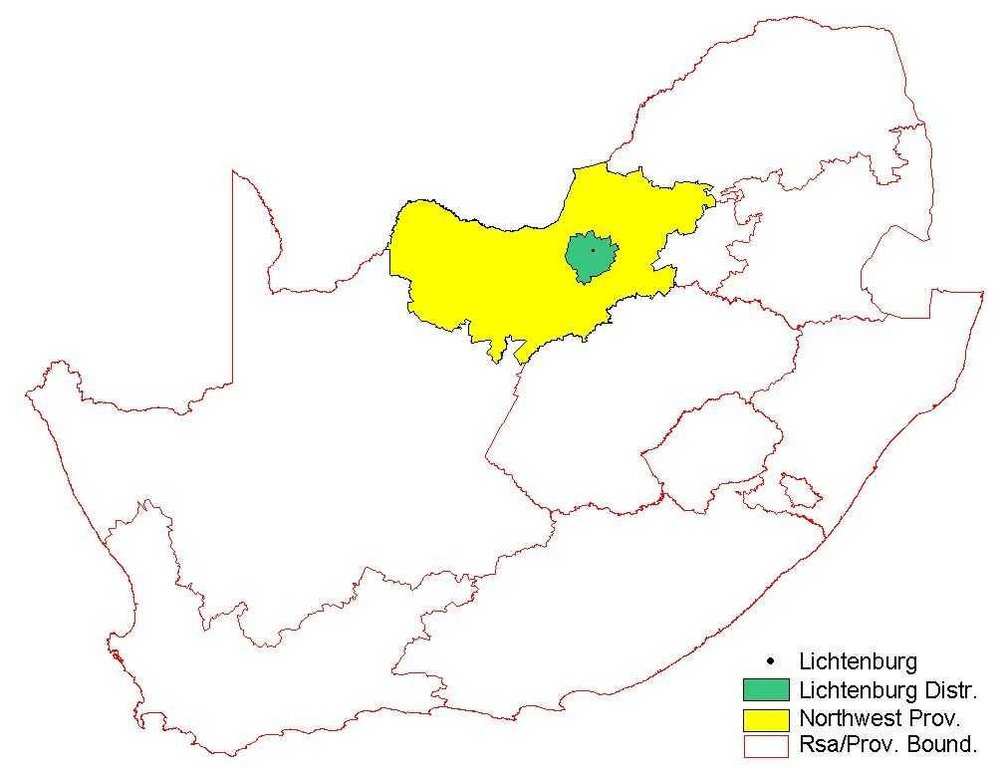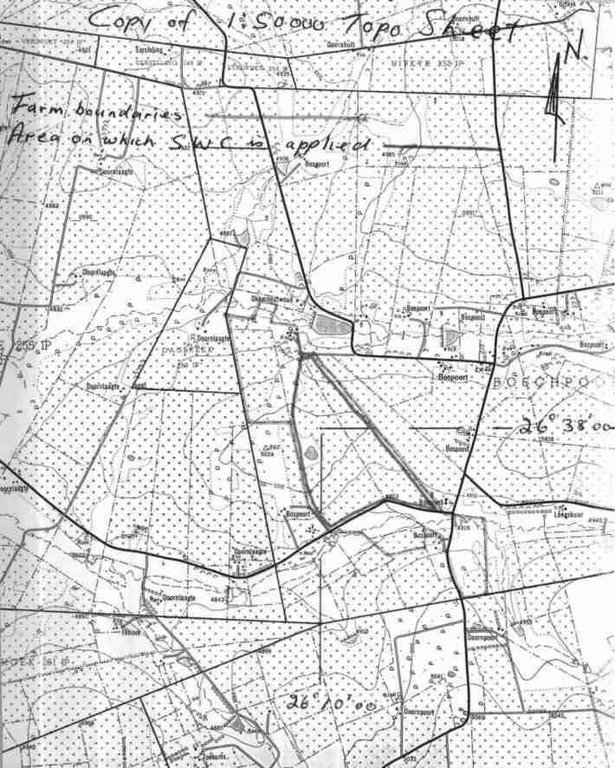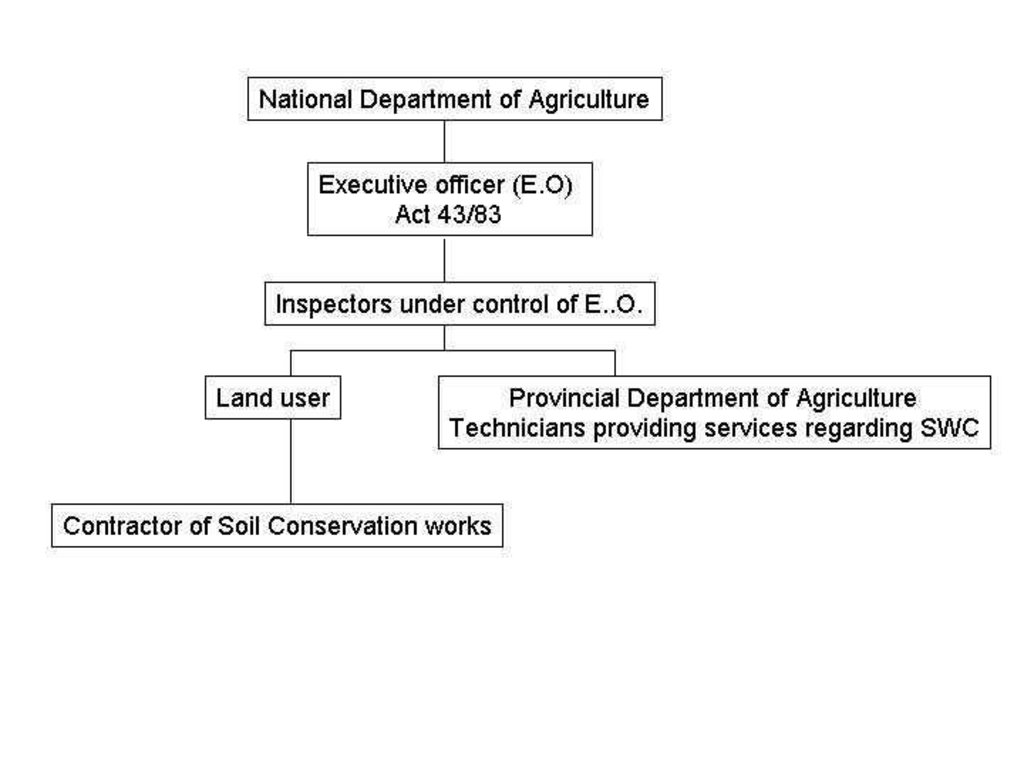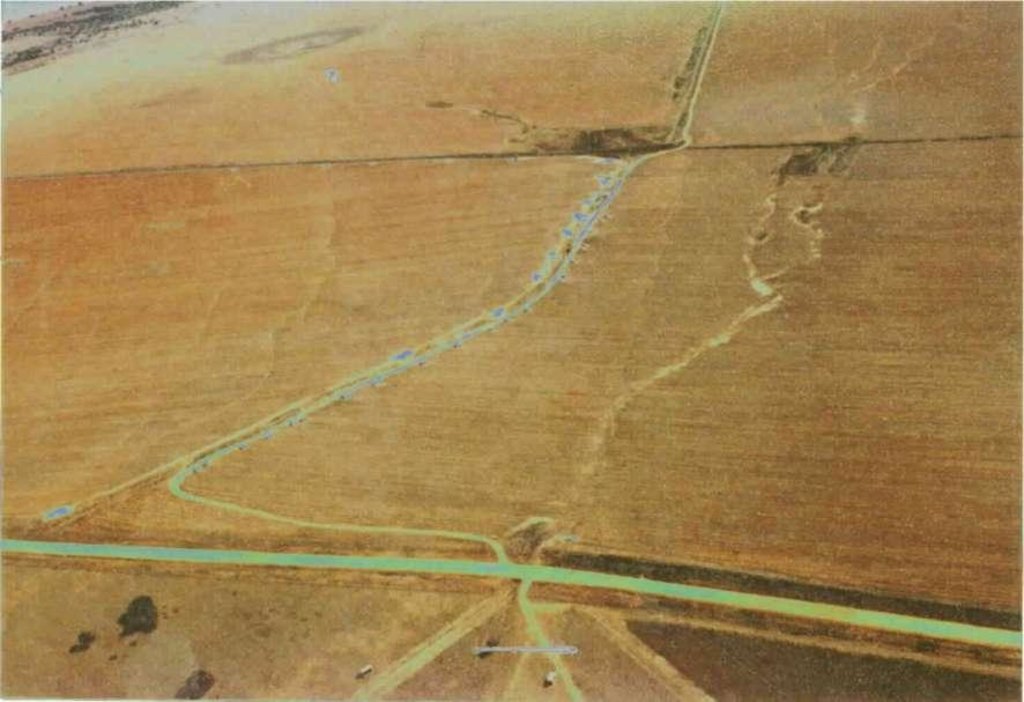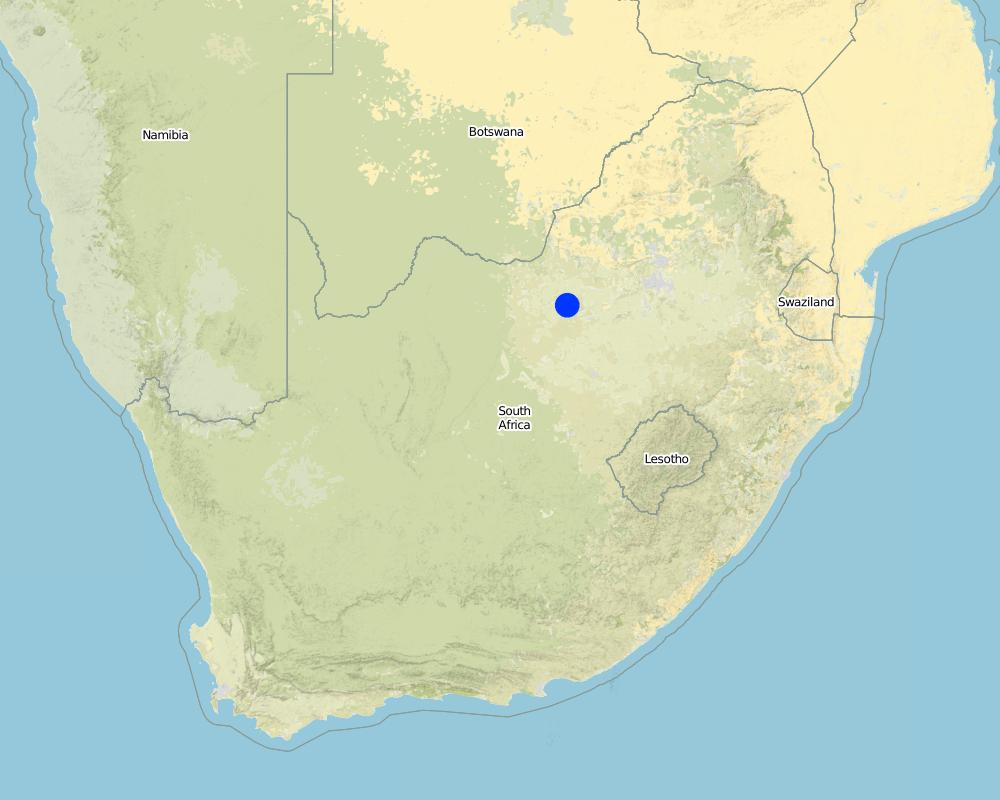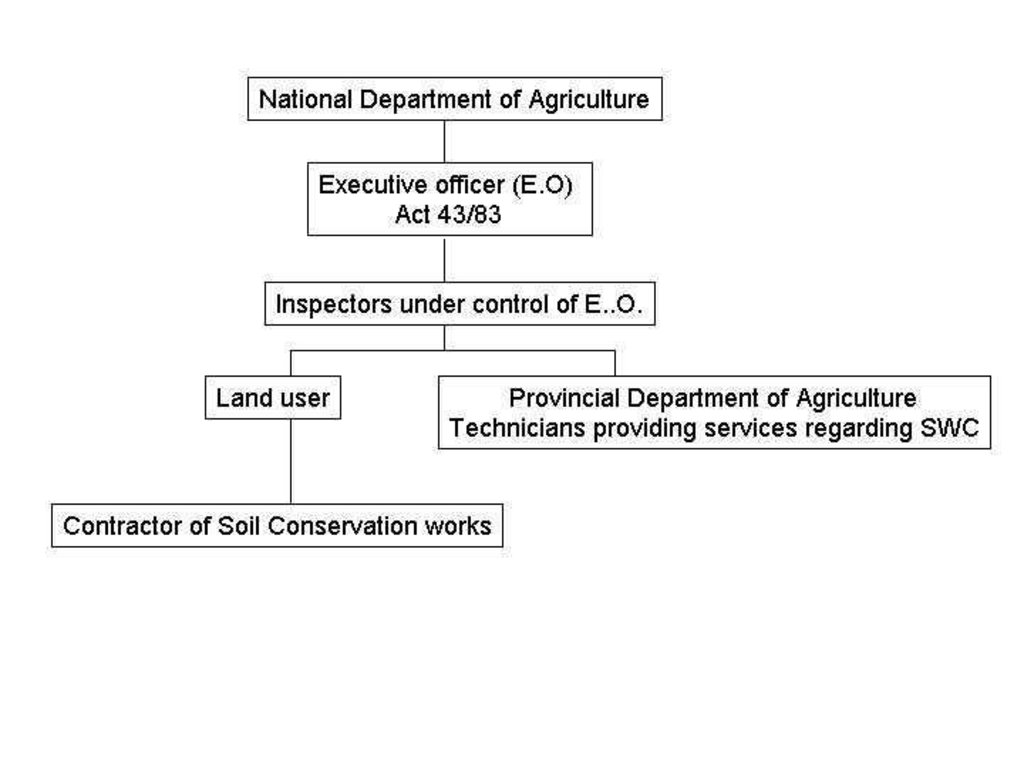All participant - Law enforcement [Afrique du Sud]
- Création :
- Mise à jour :
- Compilateur : Pieter J. Theron
- Rédacteur : –
- Examinateur : Fabian Ottiger
approaches_2647 - Afrique du Sud
Voir les sections
Développer tout Réduire tout1. Informations générales
1.2 Coordonnées des personnes-ressources et des institutions impliquées dans l'évaluation et la documentation de l'Approche
1.3 Conditions relatives à l'utilisation par WOCAT des données documentées
Le compilateur et la(les) personne(s) ressource(s) acceptent les conditions relatives à l'utilisation par WOCAT des données documentées:
Oui
1.4 Références au(x) questionnaire(s) sur les Technologies de GDT
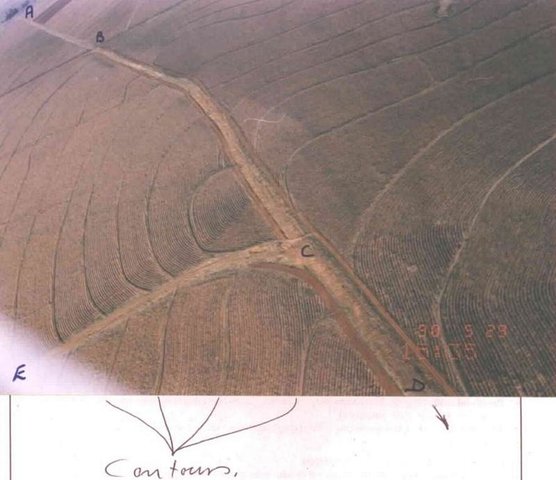
Water run-off control plan on cultivated land [Afrique du Sud]
Artificially built watercourses with contour banks with a specific gradient
- Compilateur : Ursula Gaemperli
2. Description de l'Approche de GDT
2.1 Courte description de l'Approche
Ordering a land user through the act to implement the SWC.
2.2 Description détaillée de l'Approche
Description détaillée de l'Approche:
Aims / objectives: The overall purpose of this approach was (and still is) to make the land user aware of SWC, as it was obvious that he does not intend to solve the problem of soil erosion by himself. The objective was to convince the land user to implement the technology (water run-off control planning) by building the necessary soil conservation works (via watercourses and contours and explaining in detail to him what this technology comprises:
Stages of implementation: first to make the necessary surveys from which the watercourses could be designed, then to construct the watercourse. Thirdly the watercourses must be established with a perennial grass and lastly the land user must see to it that the necessary contours are surveyed and constructed and maintained. It was also explained to the land user (farmer) that the Provincial Department of Agriculture Technical division could provide him with services regarding the planning surveying and design of the soil conservation works. The major objective was to convince the farmer that if he did not comply with the directive, legal steps could be taken against him. Fortunately, he was convinced and put in an application for a water run-off control plan after he harvested his crop in 1992. Due to a shortage in personnel, surveying only started in November 1993.
2.3 Photos de l'approche
2.5 Pays/ région/ lieux où l'Approche a été appliquée
Pays:
Afrique du Sud
Région/ Etat/ Province:
North West Province
Map
×2.6 Dates de début et de fin de l'Approche
Indiquez l'année de démarrage:
1991
Date (année) de fin de l'Approche (si l'Approche n'est plus appliquée):
1995
2.7 Type d'Approche
- fondé sur un projet/ programme
2.8 Principaux objectifs de l'Approche
The Approach focused on SLM only
1.) Construction of watercourses 2.) Establish grass in the watercourses 3.) Construction of contours
The SLM Approach addressed the following problems: The attitude of the farmer and to prevent conflict. To convince the farmer to give his co-operation without treading him with legal steps.
2.9 Conditions favorisant ou entravant la mise en œuvre de la(des) Technologie(s) appliquée(s) sous l'Approche
normes et valeurs sociales/ culturelles/ religieuses
- entrave
Poor conservation ethic, resistance to change
Treatment through the SLM Approach: Discussions
disponibilité/ accès aux ressources et services financiers
- entrave
This technology can be expensive although being subsides by government
Treatment through the SLM Approach: Subsidies
cadre juridique (régime foncier, droits d'utilisation des terres et de l'eau)
- favorise
The existing land ownership, land use rights / water rights greatly helped the approach implementation: The importance of the owners responsibility to contribute towards sustainability for the benefit of descendants.
connaissances sur la GDT, accès aux supports techniques
- entrave
Lack of technical knowledge on how to solve the problem
Treatment through the SLM Approach:
3. Participation et rôles des parties prenantes impliquées dans l'Approche
3.1 Parties prenantes impliquées dans l'Approche et rôles
- exploitants locaux des terres / communautés locales
Only one farmer
- gouvernement local
Provincial Government to deliver services and administrate the scheme
- gouvernement national (planificateurs, décideurs)
Responsible for law enforcement
3.2 Participation des exploitants locaux des terres/ communautés locales aux différentes phases de l'Approche
| Participation des exploitants locaux des terres/ communautés locales | Spécifiez qui était impliqué et décrivez les activités | |
|---|---|---|
| initiation/ motivation | aucun | |
| planification | aucun | |
| mise en œuvre | aucun | |
| suivi/ évaluation | aucun | |
| Research | aucun |
3.3 Diagramme/ organigramme (si disponible)
3.4 Prises de décision pour la sélection de la Technologie/ des Technologies
Indiquez qui a décidé de la sélection de la Technologie/ des Technologies à mettre en œuvre:
- les spécialistes de la GDT seuls
Expliquez:
directive (top-down). Directive from the act after discussed with the land user.
Decisions on the method of implementing the SLM Technology were made by by SLM specialists alone (top-down). directive (top-down). Including discussions with farmer
4. Soutien technique, renforcement des capacités et gestion des connaissances
4.1 Renforcement des capacités/ formation
Une formation a-t-elle été dispensée aux exploitants des terres/ autres parties prenantes?
Oui
Formats de la formation:
- entre agriculteurs (d'exploitants à exploitants)
Thèmes abordés:
Informal regarding how to maintain the soil conservation works and how to cultivate the lands with contours.
4.2 Service de conseils
Les exploitants des terres ont-ils accès à un service de conseils?
Oui
Spécifiez si le service de conseils est fourni:
- dans les champs des exploitants?
Décrivez/ commentez:
Convincing and persuasion; Key elements: Understanding of how the technology function, Important aspects of maintenance, Technical support free of charge; 1) Advisory service was carried out through: government's existing extension system 2) Advisory service was carried out through: government's existing extension system; Extension staff: mainly government employees 3) Target groups for extension: land users (one); Activities: Explaining how the technology function.
Advisory service is totally inadequate to ensure the continuation of land conservation activities; A huge amount of cultivated land needs protection through this technology. The government cannot offer enough personnel to deliver the service.
4.4 Suivi et évaluation
Le suivi et l'évaluation font ils partie de l'Approche? :
Oui
Commentaires:
technical aspects were ad hoc monitored through observations
area treated aspects were ad hoc monitored through observations
There were several changes in the Approach as a result of monitoring and evaluation: The farmer is well informed how the technology function as well as how to maintain it.
5. Financement et soutien matériel externe
5.1 Budget annuel de la composante GDT de l'Approche
Si le budget annuel précis n'est pas connu, indiquez une fourchette:
- 2 000-10 000
Commentez (par ex. principales sources de financement/ principaux bailleurs de fonds):
Approach costs were met by the following donors: government (national - Subsidy scheme): 70.0%; other (land owner (farmer)): 30.0%
5.3 Subventions pour des intrants spécifiques (incluant la main d'œuvre)
Si la main d'œuvre fournie par les exploitants des terres était un intrant substantiel, elle était:
- payée en espèces
Commentaires:
Contractor
5.4 Crédits
Des crédits ont-ils été alloués à travers l'Approche pour les activités de GDT?
Non
6. Analyses d'impact et conclusions
6.1 Impacts de l'Approche
Est-ce que l'Approche a aidé les exploitants des terres à mettre en œuvre et entretenir les Technologies de GDT?
- Non
- Oui, un peu
- Oui, modérément
- Oui, beaucoup
The farmer experienced that normal rainfall is evenly spreaded. In cases of heavy rain storms the soil is effectively protected against erosion.
Did other land users / projects adopt the Approach?
- Non
- Oui, un peu
- Oui, modérément
- Oui, beaucoup
This approach is also applied on overgrazing deduced weeds and other problems regarding resource conservation.
6.3 Durabilité des activités de l'Approche
Les exploitants des terres peuvent-ils poursuivre ce qui a été mis en œuvre par le biais de l'Approche (sans soutien extérieur)?
- non
Si non ou incertain, spécifiez et commentez:
Not the approach itself but the effect of the approach.
6.4 Points forts/ avantages de l'Approche
| Points forts/ avantages/ possibilités du point de vue de l'exploitant des terres |
|---|
| Trigger what he already planned to do and implement the technology (How to sustain/ enhance this strength: Sound maintenance) |
| Points forts/ avantages/ possibilités du point de vue du compilateur ou d'une autre personne ressource clé |
|---|
| Supported by legislation (How to sustain/ enhance this strength: Sound persuasion skills) |
6.5 Faiblesses/ inconvénients de l'Approche et moyens de les surmonter
| Faiblesses/ inconvénients/ risques du point de vue de l’exploitant des terres | Comment peuvent-ils être surmontés? |
|---|---|
| Dislike of law enforcement | Sound persuasion skills from inspector |
| Resistance to cooperate | Sound persuasion skills from inspector |
| Faiblesses/ inconvénients/ risques du point de vue du compilateur ou d'une autre personne ressource clé | Comment peuvent-ils être surmontés? |
|---|---|
| Great possibility for confrontation | Sound persuasion skills |
7. Références et liens
7.1 Méthodes/ sources d'information
- visites de terrain, enquêtes sur le terrain
- interviews/entretiens avec les exploitants des terres
Liens et modules
Développer tout Réduire toutLiens

Water run-off control plan on cultivated land [Afrique du Sud]
Artificially built watercourses with contour banks with a specific gradient
- Compilateur : Ursula Gaemperli
Modules
Aucun module trouvé



